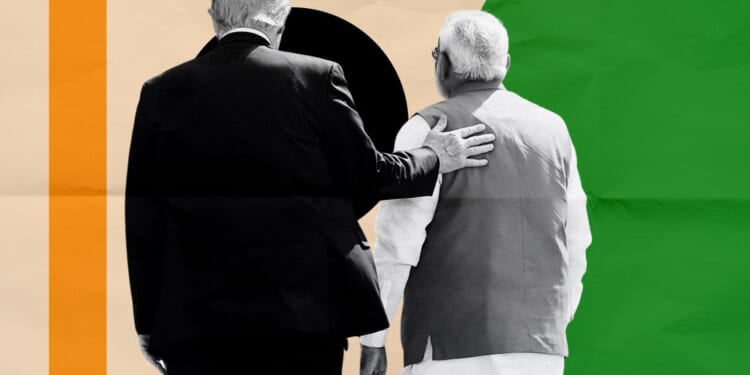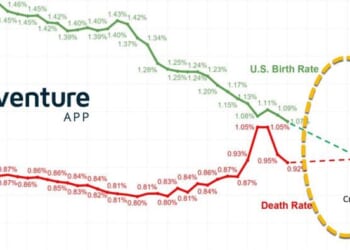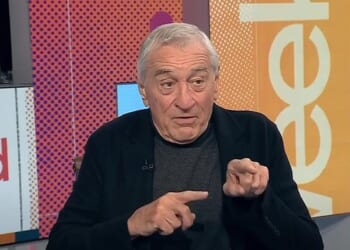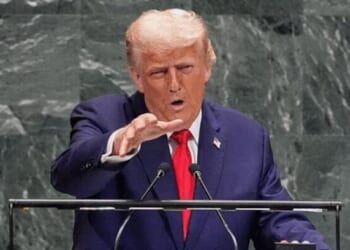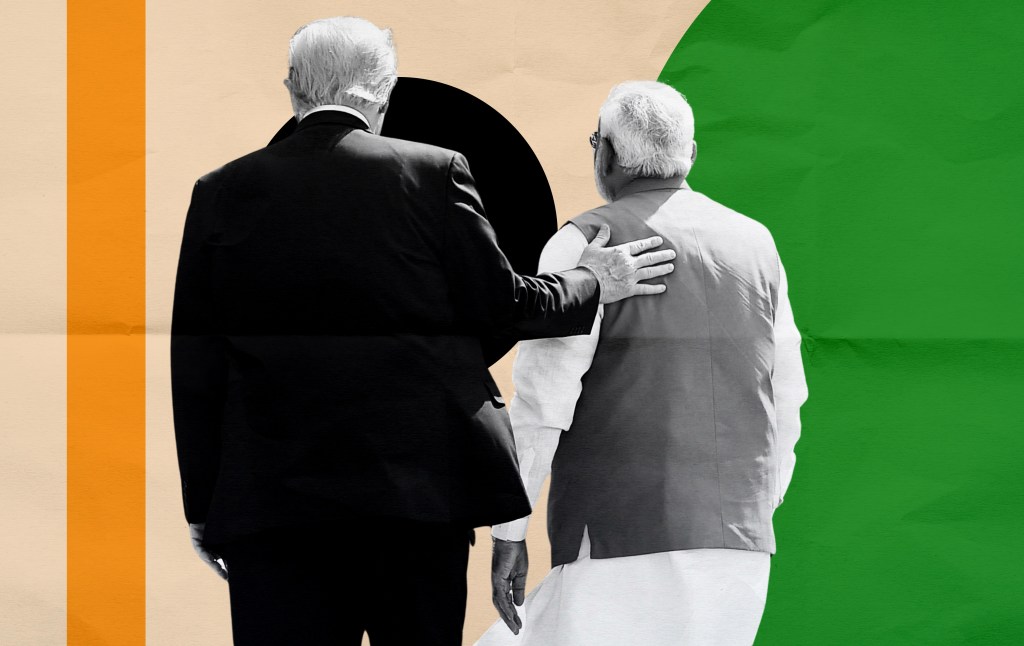
In August, President Donald Trump turned his ire toward India, purportedly for continuing to purchase oil from Russia and thus financing Vladimir Putin’s war machine. But his harshly critical rhetoric and the tariffs he applied were in keeping with previous and longstanding complaints about a raft of Indian trade practices he deems unfair. Trump’s critics have responded by pointing to the valuable role India plays in U.S. efforts to contain China. These critics have a point—but they overstate their case. India is an important situational partner to the United States, but it is in no way a permanent ally of the free world.
The president’s critics are firing from both sides. In Foreign Affairs, former Biden administration officials Kurt Campbell and Jake Sullivan advocated for a treaty alliance between the two countries, calling India one of our “most important global partners.” From the right, Walter Russell Mead highlighted India’s recent moves toward the United States and away from the non-aligned movement.
These critics get a lot right. India is the world’s largest nation. It has a large number of technical experts and software engineers who will make it only more relevant as digital technologies become a larger part of the global economy and ever more integrated into advanced weaponry. Its economy has undergone a meteoric rise since the turn of the century, having grown nine-fold since 2000. It has 1.4 billion increasingly wealthy consumers, a market with the capacity to reshape global trade patterns.
Like America, India is also uneasy about the rise of China, with which it shares a 2,000-mile border. The two sides fought a sharp but short war in 1962, have unsettled frontiers, and engaged in a brief yet fatal military skirmish in 2020. China’s ties with Sri Lanka, Nepal, and Pakistan—and its illegal construction of whole towns within Bhutan—leave India fearing encirclement. The Dalai Lama, who fled into exile from China in 1959, lives in India along with a thriving Tibetan community.
Integrating with India is a good way for the U.S. to mitigate the pain of countering Beijing. Decoupling from China would be far costlier if not for the rise of the Indian labor market. Apple, which has long relied on Chinese manufacturing, is set to produce all its new iPhone models in India beginning this year, thanks to cheap technical labor and a maturing infrastructure. Deepening ties with India could also ease the military containment of China. India is the only nation with a population on par with China’s, and a mutual defense treaty would, theoretically, erase China’s manpower advantage.
Considering the economic potential of the world’s largest democracy, including as a hedge against China, the George W. Bush administration launched what has become a quarter-century of warming relations with India. Most notably, the administration reached an agreement on civil nuclear cooperation with India. Bush dropped sanctions imposed after India’s 1998 nuclear test and initiated arms sales to the country.
Yet the road has been bumpy. “The relationship,” Campbell and Sullivan write, “has remained vulnerable to misunderstandings, missteps, and missed opportunities because of lingering distrust and misaligned expectations.” India has reasons to distrust America. The United States, after all, supported Pakistan, India’s greatest adversary, in the 1971 Indo–Pakistani War. More recently, the very Bush administration that tried to improve relations with India also worked to strengthen Pakistan, a futile effort (as the Indians warned it would be) to secure Pakistani cooperation in Afghanistan.
But the larger problem rests with India. Indo-American relations are aligned on a variety of specific issues, but they are fundamentally at odds. Since 1945, the United States has sought a preponderance of power in the Eurasian rimland. Out of a fear for the emergence of a hegemonic power in Eurasia, which led to two world wars in the 20th century, America had to become the hegemon itself. Indian foreign policy, however, favors multipolarity, due to a resentment of its past imperial subjugation and because of ambitions typical to a nation-state with a large population. While America seeks supremacy in Eurasia, at least for now India opposes unipolarity, be it American or Chinese.
In 2004, then-Prime Minister Shri Atal Bihari Vajpayee remarked, “We believe a stable equilibrium lies in a cooperative multipolar world which accommodates the legitimate aspirations and interests of all its component poles and of the international community as a whole.” Foreign Minister Subrahmanyam Jaishankar frequently echoes this sentiment. The rise of India and China, he says, is a “returning to the natural order”:
[Look, there are about 200 countries in the world. They cover very different geographies, very different cultures. It can’t be that the entirety of the world is determined by the institutions and practices of the Euro-Atlantic cultural sphere. And yet that is exactly how it was. This was a consequence of the era of colonialism, when a single, shall we say, geography claimed dominance over the whole world and subjugated other economies, political systems and cultures. Many think this dominance is the “natural world order.” But no – it is the product of a historical experience. When I say we are returning to the natural order, I mean that those who were the losers of this development are now slowly returning, having gained their independence. The most important examples are China and India.
Current Prime Minister Narendra Modi, for his part, has not shied away from this framing. The Indian government’s readout on his recent meeting with Xi Jinping asserted that “a stable relationship and cooperation between India and China … are necessary for the growth and development of the two countries, as well as for a multipolar world and a multipolar Asia befitting the trends of the 21st century.” Fostering a multipolar world is not a new goal for Modi. Speaking in 2018 at the Shangri-La Dialogue in Singapore, he said that he and Putin “shared our views on the need for a strong multipolar world order for dealing with the challenges of our times.” Fast-forward to the 2025 BRICS (Brazil, Russia, India, China, and South Africa) summit and Modi again posited that “today the world needs a new multipolar and inclusive world order.”
India undoubtedly has differences with China and Russia, with its BRICS partners and its Shanghai Cooperation Organization partners, but it welcomes and, indeed, prizes their potential to serve as counterweights to the “Euro-Atlantic cultural sphere.” A world in which America leads is less appealing to Delhi than a world in which India’s primary security threats challenge that leadership.
Indian policy is consistent with this preference for multipolarity—and discomfit with the U.S.-led order in which India has thrived. India has been a major customer of both Iranian and Russian oil despite Iran’s sponsorship of Islamic terror and Russia’s invasion of a sovereign neighbor. (When Modi and Putin met on September 1, Modi insisted that “India and Russia have always stood shoulder-to-shoulder even in the most difficult situations”.) From Delhi’s perspective, it benefits from cheap energy and from the survival of alternate power centers to those of Beijing, Riyadh, Jerusalem, Brussels, and Washington. In 2017, after 12 years of observer status, India became a full member of the Shanghai Cooperation Organization, which China and Russia founded and employ to build alternate security mechanisms in Central Asia to those proffered by the United States. A member of the BRICS intergovernmental organization since its founding in 2009, India has worked with the other members on economic initiatives that threaten to undermine U.S. dollar dominance.
India’s interpretation of international maritime law is more in line with China’s than America’s. As with Beijing and the South China Sea, Delhi insists it can regulate the activity of foreign naval vessels within its exclusive economic zone, a position inconsistent with the text of the United Nations Convention on the Law of the Sea, to which both countries are parties. Also like Beijing, Delhi draws “straight baselines” around offshore island groupings, a right reserved for island nation-states, not nation-states with some islands. Both countries do so to claim a larger maritime territory than international law permits. Although China defends its actions far more brazenly than does India—the Indian Navy does not, for example, harass U.S. naval vessels in the Indian Ocean—both seek to reshape an international maritime order that has served the democratic world well.
Nor is it clear that India seeks a world that is conducive to the thriving of liberal democracies. In his memoirs, Decision Points, Bush wrote, “The deal was the culmination of our efforts to improve relations between the world’s oldest democracy and the world’s largest democracy.” Despite its status as the world’s largest democracy, its record on freedom and human rights, never optimal, has been on the wrong trajectory for a decade. Freedom House scores India’s freedom at 63 out of 100—only “partly free,” highlighting in particular limited civil liberties—down from 78 and “free” in 2015. The State Department’s most recent human rights report on India highlights “significant human rights issues,” including “arbitrary or unlawful killings; disappearances; torture or cruel, inhuman, or degrading treatment or punishment; arbitrary arrest or detention; transnational repression … serious restrictions on freedom of expression and media freedom; and instances of coerced abortion or forced sterilization.” Examples include forced confession by the police which has resulted in deaths, state-level restrictions on non-Hindu faiths, including Christians, and persecution of Muslims by Hindu mobs. In the free world’s ideological confrontation with the world’s authoritarians, India may not prove to be a reliable partner.
Worse, it is already undermining the rule of law abroad. In 2023, Canada claimed that the Indian government had supported the assassination of Sikh activist Hardeep Singh Nijjar in British Columbia. India claims that Najjar was the leader of the militant group Khalistan Tiger Force. Even if true, extrajudicial assassination on the soil of a liberal democracy is an unacceptable move. A U.S. Department of Justice indictment confirmed that an Indian official had ordered the assassination.
Indian leaders could hardly be clearer that they see foreign countries as potential partners of convenience to advance parochial Indian interests and not permanent allies. As it continues its illiberal march, India will be even less invested in membership in the liberal coalition.
U.S. policy toward India should be grounded in the reality of Indian foreign policy vision and the limits it imposes. But a more limited U.S.-India partnership can still serve American interests.
During the late Cold War, for example, China proved to be a useful partner against the Soviet Union. But as the Cold War ended and the Soviet Union disintegrated, divergent interests reasserted themselves. The long period of engagement between the Tiananmen Square massacre and the election of Donald Trump came about because Americans gambled that they could change Chinese state interests, not because interests were aligned. Then-Deputy Secretary of State Robert Zoellick’s insistence that China could become a “responsible stakeholder” of the international order was a result of this naïve idea. India is far from becoming the People’s Republic of China—for one thing, it is not a totalitarian, genocidal state interested in territorial expansion—and its partnership with the United States is much more promising. But the story of the U.S.-China relationship is a cautionary tale and should remind policymakers today that shared adversaries do not make for enduring alliances.
U.S.-Turkey relations also illuminate. Like India today, Turkey during the Cold War was, in the words of Dean Acheson, an “imperfect democracy,” but indispensable because of its geographic position abutting the Soviet Union and the Middle East. Unshackled from the Soviet threat, however, Turkey has been free to pursue its own ambitions, causing American policymakers many headaches and moving the relationship toward transactionalism.
Under current trajectories, U.S. relations with India will be like those with China during the Cold War and with Turkey today, because New Delhi is only a reluctant participant in the American order in Eurasia. Accepting these limits, U.S. policymakers should manage their expectations and design a policy grounded in shared threats, not shared values or even shared outlooks. A productive relationship is possible. A transformational relationship is not.

